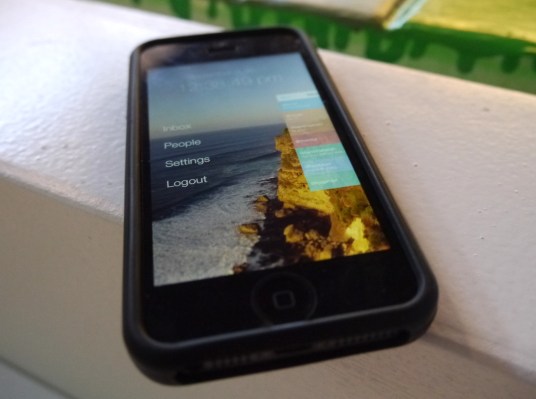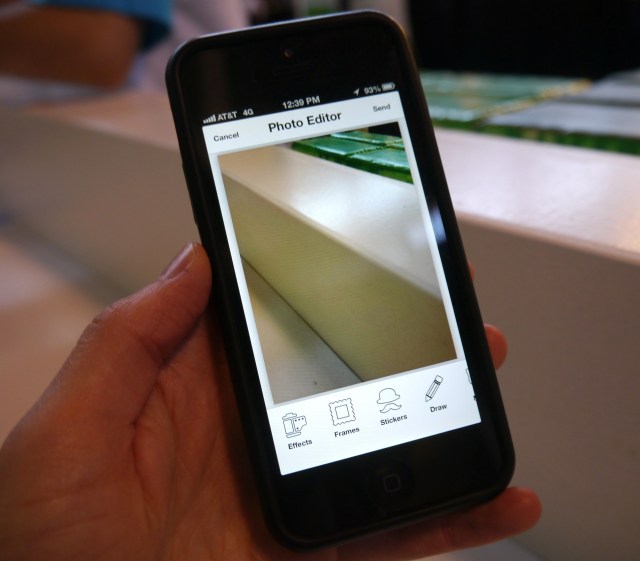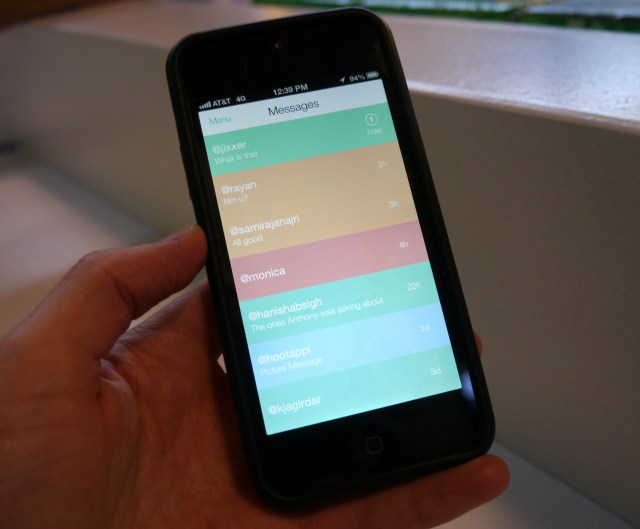Is there room for another mobile messaging app? It’s undoubtedly a very crowded space, packed with veteran behemoths and fast growing upstarts duking it out for users’ attention. But New Jersey-based startup, Inbox, which dropped by the Office Hours booth at TechCrunch Disrupt to demo its iOS app ahead of launch, reckons there’s room for a little more disruption.
CEO and founder Maher Janajri says his underlying vision is that despite the rise of multiple OTT (over-the-top) messaging players the category remains pointlessly fragmented, leaving scope for an app that draws in different messaging types and extends their capabilities in various neat ways. The basic problem as he sees it? “Why do I have three apps on my phone that effectively do the same thing?”
Inbox takes some of its messaging cues from email management app Mailbox, with the mission of applying a similarly elegant management functionality across the messaging board — not just to email, but to SMS and OTT messaging. The basic idea is to collapse the functionality gaps that keep these different channels stuck in separate silos.
Janajri explained that he finds SMS too limiting, with no option to ‘notify me later’ for an incoming SMS, for instance. It’s those sort of inconsistencies Inbox wants to iron out. That said, breaking the SMS wall down isn’t currently possible on iOS because of system restrictions. Android’s openness has no such limit, though, so that platform will allow inbox to loop in old school texting too.
Despite that troublesome inconsistency, Inbox is not going to be Android only. Indeed, its iOS app will come out first. It’s therefore offering more than just more nuanced SMS, with a feature set includes a bundle of neat stuff such as the ability to remove a message you sent from someone else’s phone with a simple swipe to delete action.
Other savvy, privacy-focused features with a Snapchattish feel include the ability to conceal the contents of your messages under redaction-style bars by shaking your phone (if you’re worried about shoulder-surfers, for instance). Concealed messages can then be peeked at individually by holding your finger on the screen — a gesture every Snapchat user is familiar with.
Inbox also includes a handsome-looking photo-editor for picture messaging, fully kitted out with filters, fun effects, meme generation tools and more. The iOS app will include a disappearing photo messaging feature that notifies users if the other person screenshotted their self-destructing photo — and sends them a copy of that screenshot so they know exactly what the other person captured, which goes one better than Snapchat.
The app combines these features with an elegant design — that looks almost Windows Phone-esque. On the design side, Janajri said: “We wanted to do something different. When people first saw this they were like, this does not look like an iOS app at all. Very flat. It also coincided well with iOS 7. I wouldn’t say that was inspiration it was more kind of coincidence… We feel like it’s different, it’s refreshing.”
Inbox allows users to choose whether to use it anonymously (i.e. by being contactable via just an Inbox moniker of their choosing) or to provide full contact information (such as their name, mobile phone number and any email addresses) to contacts.
It’s also actively drawing email into its mix by automatically giving its users an email address, as an integrated part of their account — which may seem odd to veteran email users still maintaining a portfolio of multiple email accounts but isn’t so strange if your target demographic is to a younger type of user that’s more likely to be Snapchatting and WhatsApping than sending emails. “We want to give those younger demographic users an email address without them having to sign up for it,” he says. “They just get it.
Janajri is gearing up to launch Inbox on iOS imminently — likely in the next week or so. An Android app will follow which will be able to deliver on the full message convergence vision by incorporating SMSes into its unified inbox. However it won’t be offering that feature in the first version of the Android app.
What about the business model? Monetising in the near term is likely to be via stickers — a fast-becoming staple revenue generator tool for social messaging services. “It’s actually not us [wanting to push stickers in], it’s a pull,” says Janajri. “The people who are on it are saying ‘where are the stickers?’ So that’s probably going to be near-term revenue.”
Inbox has come out of New Jersey accelerator TechLaunch, which invested $25,000 in early funding. Janajri says its launch strategy to build out a user-base once the app goes live in the App Store will be focused on marketing it to existing “tight knit communities”, such as universities.



